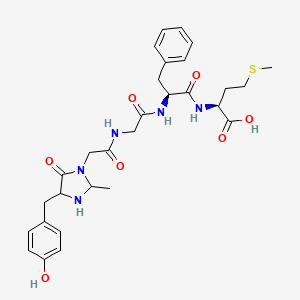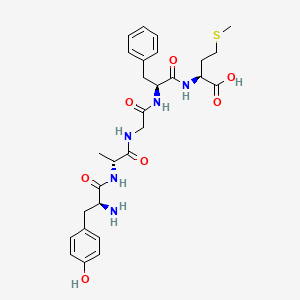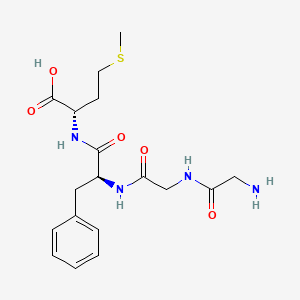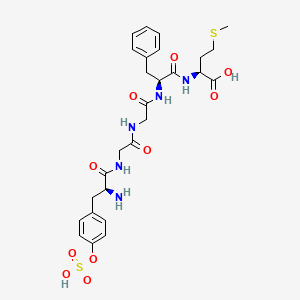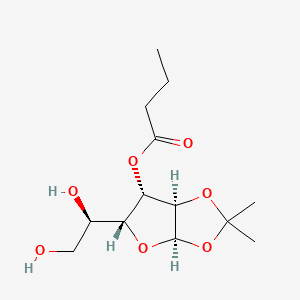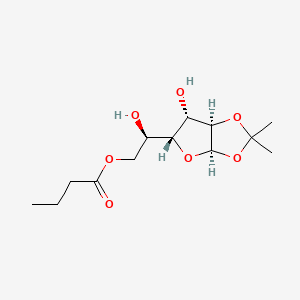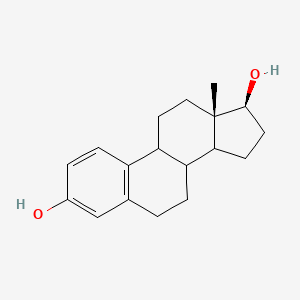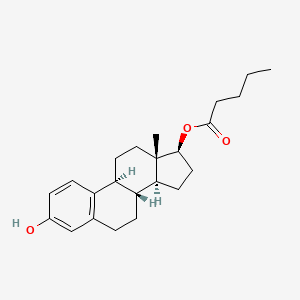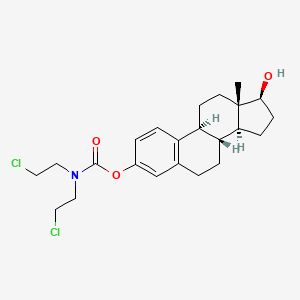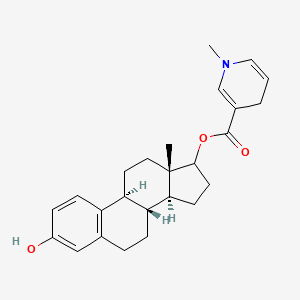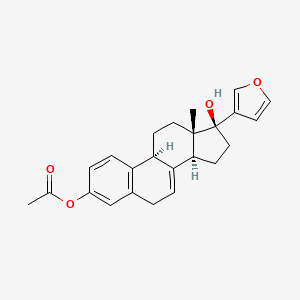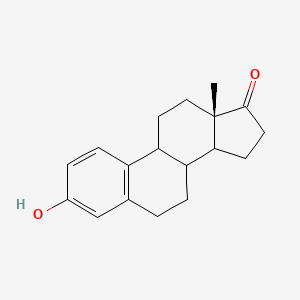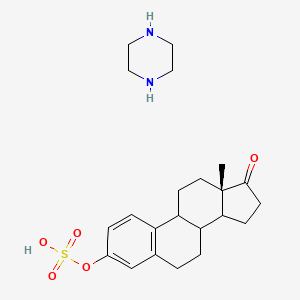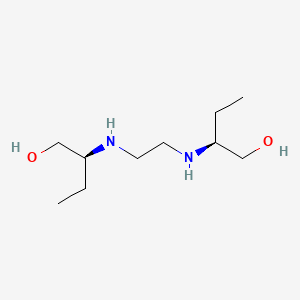
Ethambutol
Vue d'ensemble
Description
Ethambutol is an ethylenediamine derivative that is ethane-1,2-diamine in which one hydrogen attached to each of the nitrogens is sutstituted by a 1-hydroxybutan-2-yl group (S,S-configuration). It is a bacteriostatic antimycobacterial drug, effective against Mycobacterium tuberculosis and some other mycobacteria. It is used (as the dihydrochloride salt) in combination with other antituberculous drugs in the treatment of pulmonary and extrapulmonary tuberculosis; resistant strains of M. tuberculosis are readily produced if this compound is used alone. It has a role as an antitubercular agent, an environmental contaminant and a xenobiotic. It is a member of ethanolamines and an ethylenediamine derivative.
This compound hydrochloride is an antibacterial prescription medicine approved by the U.S. Food and Drug Administration (FDA) for the treatment of active tuberculosis (TB) of the lungs. (Active TB is also called TB disease.)
TB can be an opportunistic infection (OI) of HIV.
This compound is a bacteriostatic agent indicated alongside medications such as [isoniazid], [rifampin], and [pyrazinamide] in the treatment of pulmonary tuberculosis. This compound was first described in the literature in 1961. It was developed out of a need for therapies active against isoniazid resistant strains of Mycobacterium tuberculosis. this compound was granted FDA approval on 6 November 1967.
This compound is an Antimycobacterial.
This compound is a first line but adjunctive antituberculosis medication which is used only in combination with other agents such as isoniazid and rifampin. This compound therapy has been associated with minor, transient and asymptomatic elevations in serum aminotransferase levels, and is a reported but rare cause of clinically apparent acute liver injury.
This compound is a natural product found in Aspergillus sclerotiorum with data available.
This compound is an antibiotic with bacteriostatic, antimicrobial and antitubercular properties. This compound interferes with the biosynthesis of arabinogalactan, a major polysaccharide of the mycobacterial cell wall. It inhibits the polymerization of cell wall arabinan of arabinogalactan and lipoarabinomannan by blocking arabinosyl transferases and induces the accumulation of D-arabinofuranosyl-P-decaprenol, an intermediate in arabinan biosynthesis. This results in halting bacterial growth.
This compound Hydrochloride is the hydrochloride salt form of this compound, an ethylenediamine derivative with antibacterial activity, specifically effective against mycobacteria. Although the exact mechanism of action of this compound hydrochloride is unknown, this compound hydrochloride inhibits the transfer of mycolic acids into the cell wall of bacteria, which impedes bacterial cell growth. This agent may also interfere with RNA synthesis or inhibit other cell metabolism, thereby preventing cell multiplication and causing cell death.
An antitubercular agent that inhibits the transfer of mycolic acids into the cell wall of the tubercle bacillus. It may also inhibit the synthesis of spermidine in mycobacteria. The action is usually bactericidal, and the drug can penetrate human cell membranes to exert its lethal effect. (From Smith and Reynard, Textbook of Pharmacology, 1992, p863)
Mécanisme D'action
Target of Action
Ethambutol primarily targets the arabinosyltransferases (embA, embB, and embC) . These enzymes are crucial for the synthesis of the mycobacterial cell wall .
Mode of Action
This compound diffuses into Mycobacterium cells . Once inside the cell, it inhibits the arabinosyltransferases, preventing the formation of the cell wall components arabinogalactan and lipoarabinomannan . This inhibition prevents cell division .
Biochemical Pathways
The inhibition of arabinosyltransferases by this compound affects the peptidoglycan biosynthesis pathway . This pathway is responsible for the production of arabinogalactan and lipoarabinomannan, key components of the mycobacterial cell wall . The disruption of this pathway leads to a decrease in the number of binding sites for mycolic acid, leading to the accumulation of mycolic acid, trehalose monomycolate, and trehalose dimycolate .
Pharmacokinetics
This compound is approximately 75-80% orally bioavailable . A 25 mg/kg oral dose of this compound reaches a Cmax of 2-5 µg/mL, with a Tmax of 2-4 hours . The clearance and volume of distribution were estimated to be 77.4 liters/h and 76.2 liters, respectively . A G/A mutation with regard to CYP1A2 2159 G>A was associated with a 50% reduction in relative bioavailability .
Result of Action
The inhibition of arabinosyltransferases by this compound leads to a decrease in the concentrations of arabinogalactan in the cell wall . This reduces the number of binding sites for mycolic acid, leading to the accumulation of mycolic acid, trehalose monomycolate, and trehalose dimycolate . Reduced levels of lipoarabinomannan may interfere with mycobacterial interaction with host cells .
Action Environment
The action, efficacy, and stability of this compound can be influenced by various environmental factors. It’s important to note that the pharmacokinetics and pharmacodynamics of this compound can be affected by individual patient characteristics, including genetic polymorphisms .
Applications De Recherche Scientifique
Activité antituberculeuse
L'Ethambutol fait partie de la chimiothérapie de première ligne recommandée par l'Organisation mondiale de la santé contre la tuberculose (TB) depuis plus de 50 ans . Il continue d'être efficace dans le traitement de cette maladie bactérienne qui infecte des millions d'humains et de bovins chaque année dans le monde entier .
Nano-formulation avec oxyde de graphène multifonctionnel et nanoparticules magnétiques
Une nouvelle formulation multifonctionnelle anti-TB a été conçue en fabriquant de l'oxyde de graphène avec des nanoparticules de magnétite d'oxyde de fer servant de nano-porteur sur lequel l'this compound a été chargé avec succès . Cette nano-formulation conserve son activité antituberculeuse et a des perspectives d'amélioration de l'efficacité chimiothérapeutique .
Libération prolongée
La libération de l'this compound à partir de la formulation de nanoparticules multifonctionnelles anti-TB s'est avérée être soutenue sur une période de temps significativement plus longue dans une solution tampon de phosphate salin à deux pH physiologiques (7,4 et 4,8) . Cela pourrait potentiellement améliorer l'observance des patients en réduisant la durée du traitement et la fréquence des doses .
Solvants eutectiques profonds thérapeutiques (THEDES)
L'this compound a été incorporé dans des solvants eutectiques profonds thérapeutiques (THEDES) qui incluent également de la l-arginine . Cette stratégie vise à améliorer la biodisponibilité des ingrédients pharmaceutiques actifs (API) et à prévenir la résistance aux médicaments et les effets secondaires des médicaments antituberculeux .
Augmentation de la solubilité
La solubilité de l'this compound a été trouvée augmentée lorsqu'il était incorporé dans le système eutectique . Cela pourrait potentiellement améliorer l'efficacité du médicament en améliorant son absorption dans l'organisme .
Biocompatibilité
Des études sur des cellules de fibroblastes de souris 3T3 ont montré que l'this compound, lorsqu'il est utilisé à certaines concentrations, reste non toxique pour les cellules eucaryotes testées . Cela suggère que l'this compound a une bonne biocompatibilité, ce qui est un aspect clé de la recherche sur l'administration de médicaments .
Analyse Biochimique
Biochemical Properties
Ethambutol interacts with three membrane-embedded arabinosyltransferases — EmbA, EmbB, and EmbC — involved in the synthesis of the mycobacterial cell wall . It also targets the glutamate racemase (MurI), a crucial enzyme of phase I peptidoglycan (PG) biosynthesis pathway of Mycobacterium tuberculosis .
Cellular Effects
This compound exerts its effects by inhibiting the formation of cell wall components arabinogalactan and lipoarabinomannan, thereby preventing cell division . Decreased concentrations of arabinogalactan in the cell wall reduces the number of binding sites for mycolic acid, leading to the accumulation of mycolic acid, trehalose monomycolate, and trehalose dimycolate .
Molecular Mechanism
This compound binds to similar domains in EmbB and EmbC and thereby inhibits the arabinosyltransferase activity necessary for creation of components of the mycobacterial cell wall . It acts as a competitive inhibitor of substrate for binding to mycobacterial MurI protein .
Temporal Effects in Laboratory Settings
It is known that this compound’s inhibitory activity against tuberculosis is significant .
Metabolic Pathways
This compound is involved in the metabolic pathways related to the synthesis of the mycobacterial cell wall . It interacts with enzymes like EmbA, EmbB, and EmbC, and glutamate racemase (MurI) .
Propriétés
IUPAC Name |
(2S)-2-[2-[[(2S)-1-hydroxybutan-2-yl]amino]ethylamino]butan-1-ol | |
|---|---|---|
| Source | PubChem | |
| URL | https://pubchem.ncbi.nlm.nih.gov | |
| Description | Data deposited in or computed by PubChem | |
InChI |
InChI=1S/C10H24N2O2/c1-3-9(7-13)11-5-6-12-10(4-2)8-14/h9-14H,3-8H2,1-2H3/t9-,10-/m0/s1 | |
| Source | PubChem | |
| URL | https://pubchem.ncbi.nlm.nih.gov | |
| Description | Data deposited in or computed by PubChem | |
InChI Key |
AEUTYOVWOVBAKS-UWVGGRQHSA-N | |
| Source | PubChem | |
| URL | https://pubchem.ncbi.nlm.nih.gov | |
| Description | Data deposited in or computed by PubChem | |
Canonical SMILES |
CCC(CO)NCCNC(CC)CO | |
| Source | PubChem | |
| URL | https://pubchem.ncbi.nlm.nih.gov | |
| Description | Data deposited in or computed by PubChem | |
Isomeric SMILES |
CC[C@@H](CO)NCCN[C@@H](CC)CO | |
| Source | PubChem | |
| URL | https://pubchem.ncbi.nlm.nih.gov | |
| Description | Data deposited in or computed by PubChem | |
Molecular Formula |
C10H24N2O2 | |
| Source | PubChem | |
| URL | https://pubchem.ncbi.nlm.nih.gov | |
| Description | Data deposited in or computed by PubChem | |
DSSTOX Substance ID |
DTXSID8023006, DTXSID901028179 | |
| Record name | Ethambutol | |
| Source | EPA DSSTox | |
| URL | https://comptox.epa.gov/dashboard/DTXSID8023006 | |
| Description | DSSTox provides a high quality public chemistry resource for supporting improved predictive toxicology. | |
| Record name | (2R*,2'R*)-2,2'-(Ethane-1,2-diyldiimino)dibutan-1-ol | |
| Source | EPA DSSTox | |
| URL | https://comptox.epa.gov/dashboard/DTXSID901028179 | |
| Description | DSSTox provides a high quality public chemistry resource for supporting improved predictive toxicology. | |
Molecular Weight |
204.31 g/mol | |
| Source | PubChem | |
| URL | https://pubchem.ncbi.nlm.nih.gov | |
| Description | Data deposited in or computed by PubChem | |
Physical Description |
Solid | |
| Record name | Ethambutol | |
| Source | Human Metabolome Database (HMDB) | |
| URL | http://www.hmdb.ca/metabolites/HMDB0014474 | |
| Description | The Human Metabolome Database (HMDB) is a freely available electronic database containing detailed information about small molecule metabolites found in the human body. | |
| Explanation | HMDB is offered to the public as a freely available resource. Use and re-distribution of the data, in whole or in part, for commercial purposes requires explicit permission of the authors and explicit acknowledgment of the source material (HMDB) and the original publication (see the HMDB citing page). We ask that users who download significant portions of the database cite the HMDB paper in any resulting publications. | |
Solubility |
Soluble in chloroform, methylene chloride; less soluble in benzene; sparingly soluble in water, 7.58e+00 g/L | |
| Record name | Ethambutol | |
| Source | DrugBank | |
| URL | https://www.drugbank.ca/drugs/DB00330 | |
| Description | The DrugBank database is a unique bioinformatics and cheminformatics resource that combines detailed drug (i.e. chemical, pharmacological and pharmaceutical) data with comprehensive drug target (i.e. sequence, structure, and pathway) information. | |
| Explanation | Creative Common's Attribution-NonCommercial 4.0 International License (http://creativecommons.org/licenses/by-nc/4.0/legalcode) | |
| Record name | ETHAMBUTOL | |
| Source | Hazardous Substances Data Bank (HSDB) | |
| URL | https://pubchem.ncbi.nlm.nih.gov/source/hsdb/3078 | |
| Description | The Hazardous Substances Data Bank (HSDB) is a toxicology database that focuses on the toxicology of potentially hazardous chemicals. It provides information on human exposure, industrial hygiene, emergency handling procedures, environmental fate, regulatory requirements, nanomaterials, and related areas. The information in HSDB has been assessed by a Scientific Review Panel. | |
| Record name | Ethambutol | |
| Source | Human Metabolome Database (HMDB) | |
| URL | http://www.hmdb.ca/metabolites/HMDB0014474 | |
| Description | The Human Metabolome Database (HMDB) is a freely available electronic database containing detailed information about small molecule metabolites found in the human body. | |
| Explanation | HMDB is offered to the public as a freely available resource. Use and re-distribution of the data, in whole or in part, for commercial purposes requires explicit permission of the authors and explicit acknowledgment of the source material (HMDB) and the original publication (see the HMDB citing page). We ask that users who download significant portions of the database cite the HMDB paper in any resulting publications. | |
Mechanism of Action |
Ethambutol diffuses into _Mycobacterium_ cells. Once inside the cell, ethambutol inhibits the arabinosyltransferases (embA, embB, and embC), preventing formation of the cell wall components arabinogalactan and lipoarabinomannan, and preventing cell division. Decreased concentrations of arabinogalactan in the cell wall reduces the number of binding sites for mycolic acid, leading to the accumulation of mycolic acid, trehalose monomycolate, and trehalose dimycolate. Lipoarabinomannan is a component of a cell surface molecule involved in the interaction with host cells. Reduced levels of lipoarabinomannan may interfere with mycobacterial interaction with host cells., Ethambutol is bacteriostatic in action. Although the exact mechanism of action has not been fully elucidated, the drug appears to inhibit the synthesis of one or more metabolites in susceptible bacteria resulting in impairment of cellular metabolism, arrest of multiplication, and cell death. Ethambutol is active against susceptible bacteria only when they are undergoing cell division. | |
| Record name | Ethambutol | |
| Source | DrugBank | |
| URL | https://www.drugbank.ca/drugs/DB00330 | |
| Description | The DrugBank database is a unique bioinformatics and cheminformatics resource that combines detailed drug (i.e. chemical, pharmacological and pharmaceutical) data with comprehensive drug target (i.e. sequence, structure, and pathway) information. | |
| Explanation | Creative Common's Attribution-NonCommercial 4.0 International License (http://creativecommons.org/licenses/by-nc/4.0/legalcode) | |
| Record name | ETHAMBUTOL | |
| Source | Hazardous Substances Data Bank (HSDB) | |
| URL | https://pubchem.ncbi.nlm.nih.gov/source/hsdb/3078 | |
| Description | The Hazardous Substances Data Bank (HSDB) is a toxicology database that focuses on the toxicology of potentially hazardous chemicals. It provides information on human exposure, industrial hygiene, emergency handling procedures, environmental fate, regulatory requirements, nanomaterials, and related areas. The information in HSDB has been assessed by a Scientific Review Panel. | |
Color/Form |
Crystals, WHITE, CRYSTALLINE POWDER | |
CAS No. |
74-55-5, 36697-71-9 | |
| Record name | (+)-Ethambutol | |
| Source | CAS Common Chemistry | |
| URL | https://commonchemistry.cas.org/detail?cas_rn=74-55-5 | |
| Description | CAS Common Chemistry is an open community resource for accessing chemical information. Nearly 500,000 chemical substances from CAS REGISTRY cover areas of community interest, including common and frequently regulated chemicals, and those relevant to high school and undergraduate chemistry classes. This chemical information, curated by our expert scientists, is provided in alignment with our mission as a division of the American Chemical Society. | |
| Explanation | The data from CAS Common Chemistry is provided under a CC-BY-NC 4.0 license, unless otherwise stated. | |
| Record name | Ethambutol [INN:BAN] | |
| Source | ChemIDplus | |
| URL | https://pubchem.ncbi.nlm.nih.gov/substance/?source=chemidplus&sourceid=0000074555 | |
| Description | ChemIDplus is a free, web search system that provides access to the structure and nomenclature authority files used for the identification of chemical substances cited in National Library of Medicine (NLM) databases, including the TOXNET system. | |
| Record name | Ethambutol | |
| Source | DrugBank | |
| URL | https://www.drugbank.ca/drugs/DB00330 | |
| Description | The DrugBank database is a unique bioinformatics and cheminformatics resource that combines detailed drug (i.e. chemical, pharmacological and pharmaceutical) data with comprehensive drug target (i.e. sequence, structure, and pathway) information. | |
| Explanation | Creative Common's Attribution-NonCommercial 4.0 International License (http://creativecommons.org/licenses/by-nc/4.0/legalcode) | |
| Record name | Ethambutol | |
| Source | EPA DSSTox | |
| URL | https://comptox.epa.gov/dashboard/DTXSID8023006 | |
| Description | DSSTox provides a high quality public chemistry resource for supporting improved predictive toxicology. | |
| Record name | (2R*,2'R*)-2,2'-(Ethane-1,2-diyldiimino)dibutan-1-ol | |
| Source | EPA DSSTox | |
| URL | https://comptox.epa.gov/dashboard/DTXSID901028179 | |
| Description | DSSTox provides a high quality public chemistry resource for supporting improved predictive toxicology. | |
| Record name | Ethambutol | |
| Source | European Chemicals Agency (ECHA) | |
| URL | https://echa.europa.eu/substance-information/-/substanceinfo/100.000.737 | |
| Description | The European Chemicals Agency (ECHA) is an agency of the European Union which is the driving force among regulatory authorities in implementing the EU's groundbreaking chemicals legislation for the benefit of human health and the environment as well as for innovation and competitiveness. | |
| Explanation | Use of the information, documents and data from the ECHA website is subject to the terms and conditions of this Legal Notice, and subject to other binding limitations provided for under applicable law, the information, documents and data made available on the ECHA website may be reproduced, distributed and/or used, totally or in part, for non-commercial purposes provided that ECHA is acknowledged as the source: "Source: European Chemicals Agency, http://echa.europa.eu/". Such acknowledgement must be included in each copy of the material. ECHA permits and encourages organisations and individuals to create links to the ECHA website under the following cumulative conditions: Links can only be made to webpages that provide a link to the Legal Notice page. | |
| Record name | ETHAMBUTOL | |
| Source | FDA Global Substance Registration System (GSRS) | |
| URL | https://gsrs.ncats.nih.gov/ginas/app/beta/substances/8G167061QZ | |
| Description | The FDA Global Substance Registration System (GSRS) enables the efficient and accurate exchange of information on what substances are in regulated products. Instead of relying on names, which vary across regulatory domains, countries, and regions, the GSRS knowledge base makes it possible for substances to be defined by standardized, scientific descriptions. | |
| Explanation | Unless otherwise noted, the contents of the FDA website (www.fda.gov), both text and graphics, are not copyrighted. They are in the public domain and may be republished, reprinted and otherwise used freely by anyone without the need to obtain permission from FDA. Credit to the U.S. Food and Drug Administration as the source is appreciated but not required. | |
| Record name | ETHAMBUTOL | |
| Source | Hazardous Substances Data Bank (HSDB) | |
| URL | https://pubchem.ncbi.nlm.nih.gov/source/hsdb/3078 | |
| Description | The Hazardous Substances Data Bank (HSDB) is a toxicology database that focuses on the toxicology of potentially hazardous chemicals. It provides information on human exposure, industrial hygiene, emergency handling procedures, environmental fate, regulatory requirements, nanomaterials, and related areas. The information in HSDB has been assessed by a Scientific Review Panel. | |
| Record name | Ethambutol | |
| Source | Human Metabolome Database (HMDB) | |
| URL | http://www.hmdb.ca/metabolites/HMDB0014474 | |
| Description | The Human Metabolome Database (HMDB) is a freely available electronic database containing detailed information about small molecule metabolites found in the human body. | |
| Explanation | HMDB is offered to the public as a freely available resource. Use and re-distribution of the data, in whole or in part, for commercial purposes requires explicit permission of the authors and explicit acknowledgment of the source material (HMDB) and the original publication (see the HMDB citing page). We ask that users who download significant portions of the database cite the HMDB paper in any resulting publications. | |
Melting Point |
171.5-174.5, 87.5-88.8 °C, 88 °C | |
| Record name | Ethambutol | |
| Source | DrugBank | |
| URL | https://www.drugbank.ca/drugs/DB00330 | |
| Description | The DrugBank database is a unique bioinformatics and cheminformatics resource that combines detailed drug (i.e. chemical, pharmacological and pharmaceutical) data with comprehensive drug target (i.e. sequence, structure, and pathway) information. | |
| Explanation | Creative Common's Attribution-NonCommercial 4.0 International License (http://creativecommons.org/licenses/by-nc/4.0/legalcode) | |
| Record name | ETHAMBUTOL | |
| Source | Hazardous Substances Data Bank (HSDB) | |
| URL | https://pubchem.ncbi.nlm.nih.gov/source/hsdb/3078 | |
| Description | The Hazardous Substances Data Bank (HSDB) is a toxicology database that focuses on the toxicology of potentially hazardous chemicals. It provides information on human exposure, industrial hygiene, emergency handling procedures, environmental fate, regulatory requirements, nanomaterials, and related areas. The information in HSDB has been assessed by a Scientific Review Panel. | |
| Record name | Ethambutol | |
| Source | Human Metabolome Database (HMDB) | |
| URL | http://www.hmdb.ca/metabolites/HMDB0014474 | |
| Description | The Human Metabolome Database (HMDB) is a freely available electronic database containing detailed information about small molecule metabolites found in the human body. | |
| Explanation | HMDB is offered to the public as a freely available resource. Use and re-distribution of the data, in whole or in part, for commercial purposes requires explicit permission of the authors and explicit acknowledgment of the source material (HMDB) and the original publication (see the HMDB citing page). We ask that users who download significant portions of the database cite the HMDB paper in any resulting publications. | |
Retrosynthesis Analysis
AI-Powered Synthesis Planning: Our tool employs the Template_relevance Pistachio, Template_relevance Bkms_metabolic, Template_relevance Pistachio_ringbreaker, Template_relevance Reaxys, Template_relevance Reaxys_biocatalysis model, leveraging a vast database of chemical reactions to predict feasible synthetic routes.
One-Step Synthesis Focus: Specifically designed for one-step synthesis, it provides concise and direct routes for your target compounds, streamlining the synthesis process.
Accurate Predictions: Utilizing the extensive PISTACHIO, BKMS_METABOLIC, PISTACHIO_RINGBREAKER, REAXYS, REAXYS_BIOCATALYSIS database, our tool offers high-accuracy predictions, reflecting the latest in chemical research and data.
Strategy Settings
| Precursor scoring | Relevance Heuristic |
|---|---|
| Min. plausibility | 0.01 |
| Model | Template_relevance |
| Template Set | Pistachio/Bkms_metabolic/Pistachio_ringbreaker/Reaxys/Reaxys_biocatalysis |
| Top-N result to add to graph | 6 |
Feasible Synthetic Routes
Q1: What is the primary target of ethambutol in Mycobacterium tuberculosis?
A: this compound targets arabinosyltransferases, specifically EmbA, EmbB, and EmbC, which are essential enzymes for the synthesis of arabinogalactan, a key component of the mycobacterial cell wall [].
Q2: How does this compound inhibit arabinosyltransferases?
A: Structural studies reveal that this compound binds to the active site of EmbB and EmbC, occupying the same region where both the sugar donor and acceptor substrates bind. This competitive inhibition disrupts arabinogalactan synthesis, compromising the integrity of the mycobacterial cell wall [].
Q3: What are the downstream effects of this compound's inhibition of arabinogalactan synthesis?
A: Disrupting arabinogalactan synthesis weakens the mycobacterial cell wall, leading to increased permeability and eventual cell death. This inhibition also causes a build-up of arabinan precursors and their subsequent leakage from the cell wall [].
Q4: Does this compound directly interact with endogenous arabinases, enzymes known to degrade arabinan in the cell wall?
A: While this compound treatment leads to a significant loss of arabinan from the cell wall, studies in Mycobacterium smegmatis indicate this effect is not due to a direct increase in endogenous arabinase activity. Instead, this compound's disruption of cell wall integrity likely exposes arabinan to pre-existing arabinases, accelerating its degradation [].
Q5: What is the molecular formula and weight of this compound?
A: this compound has a molecular formula of C10H24N2O2 and a molecular weight of 204.31 g/mol [].
Q6: Can circular dichroism (CD) spectroscopy be used to analyze this compound?
A: While this compound itself exhibits weak optical activity, forming a copper chelate significantly enhances its CD signal. This property can be exploited for quantitative analysis of this compound by measuring the ellipticity value of its copper chelate in the CD spectrum [].
Q7: Can this compound be formulated in sustained-release microcapsules?
A: Yes, this compound hydrochloride can be encapsulated in Eudragit RS microcapsules to achieve sustained release. The incorporation of aluminum tristearate as a stabilizing agent during the microencapsulation process improves the uniformity and flow properties of the microcapsules, further influencing the drug release profile [].
Q8: How is this compound absorbed and excreted in the body?
A: this compound is well-absorbed from the gastrointestinal tract, with approximately 90% of an oral dose excreted unchanged in the urine within 24 hours [, ]. Minor metabolic conversions to aldehyde and dicarboxylic acid forms occur, with these metabolites also detected in urine [].
Q9: What factors influence this compound pharmacokinetics?
A: Body weight significantly affects this compound clearance and volume of distribution, while HIV infection is associated with reduced bioavailability []. Contrary to previous assumptions, renal function has a limited impact on this compound clearance in tuberculosis patients []. Interindividual variability in oral clearance is relatively low, but significant interoccasion variability highlights the importance of consistent dosing [].
Q10: Does the revised World Health Organization (WHO) weight-band dosing for this compound achieve target drug concentrations in children?
A: Studies indicate that the revised dosages might be suboptimal for achieving target this compound concentrations in children, particularly for rifampin and this compound. This suggests a need for higher doses of these drugs in pediatric tuberculosis treatment [].
Q11: Does obesity influence this compound dosing and potential toxicity?
A: Yes, obesity significantly impacts this compound pharmacokinetics. Dosing based on total body weight instead of ideal body weight can lead to overdosing and increased risk of ocular toxicity in obese patients due to this compound's lower volume of distribution in adipose tissue [].
Q12: How effective is this compound in treating nontuberculous mycobacterial (NTM) infections?
A: this compound demonstrates variable efficacy against NTM infections. While it shows promise against Mycobacterium kansasii, it exhibits limited effectiveness against Mycobacterium avium complex (MAC), often requiring combination therapy with other agents like rifabutin and clofazimine [, ].
Q13: Can this compound enhance the activity of other antituberculosis drugs against multidrug-resistant strains?
A: Yes, sub-inhibitory concentrations of this compound can increase the susceptibility of multidrug-resistant Mycobacterium tuberculosis strains to isoniazid, rifampin, and streptomycin. This effect is attributed to this compound's ability to modify cell wall permeability, facilitating better drug penetration [].
Q14: What is the most prominent adverse effect associated with this compound?
A: this compound's most significant adverse effect is ocular toxicity, specifically optic neuropathy, which can lead to vision loss [, , , ].
Q15: Is this compound-induced optic neuropathy reversible?
A: While often considered reversible upon drug discontinuation, studies indicate that recovery is not guaranteed, especially in older patients and those with severe visual impairment at presentation [, , , ].
Q16: What factors increase the risk of this compound-induced optic neuropathy?
A: Risk factors include: * Advanced age (over 60 years) [, ] * Prolonged duration of this compound treatment [] * High daily dosage [] * Pre-existing hypertension [] * Smoking history [] * Underlying systemic diseases like diabetes mellitus and renal disorders [] * Poor initial visual acuity at the onset of optic neuropathy []
Q17: Are there other reported side effects associated with this compound?
A: Although less common than optic neuropathy, other reported side effects include: * Peripheral neuropathy [, ] * Agranulocytosis []
Q18: Are there strategies to improve this compound delivery to its target site?
A: While specific targeted delivery strategies are not extensively discussed in the provided research, formulating this compound in sustained-release microcapsules shows promise for improving its pharmacokinetic profile and potentially enhancing its therapeutic efficacy [].
Q19: What analytical techniques are commonly used for this compound quantification?
A: * High-performance liquid chromatography (HPLC) coupled with tandem mass spectrometry (MS/MS): Offers high sensitivity and specificity for quantifying this compound in plasma [].* Liquid chromatography with UV detection: this compound's copper chelate exhibits absorbance at 270 nm, enabling its detection after chromatographic separation. An internal standard with similar chelating properties can improve accuracy [].
Q20: Can electrochemical methods be applied for this compound detection?
A: Yes, gold microelectrode arrays show promise as sensitive amperometric sensors for this compound determination in aqueous solutions [].
Avertissement et informations sur les produits de recherche in vitro
Veuillez noter que tous les articles et informations sur les produits présentés sur BenchChem sont destinés uniquement à des fins informatives. Les produits disponibles à l'achat sur BenchChem sont spécifiquement conçus pour des études in vitro, qui sont réalisées en dehors des organismes vivants. Les études in vitro, dérivées du terme latin "in verre", impliquent des expériences réalisées dans des environnements de laboratoire contrôlés à l'aide de cellules ou de tissus. Il est important de noter que ces produits ne sont pas classés comme médicaments et n'ont pas reçu l'approbation de la FDA pour la prévention, le traitement ou la guérison de toute condition médicale, affection ou maladie. Nous devons souligner que toute forme d'introduction corporelle de ces produits chez les humains ou les animaux est strictement interdite par la loi. Il est essentiel de respecter ces directives pour assurer la conformité aux normes légales et éthiques en matière de recherche et d'expérimentation.


